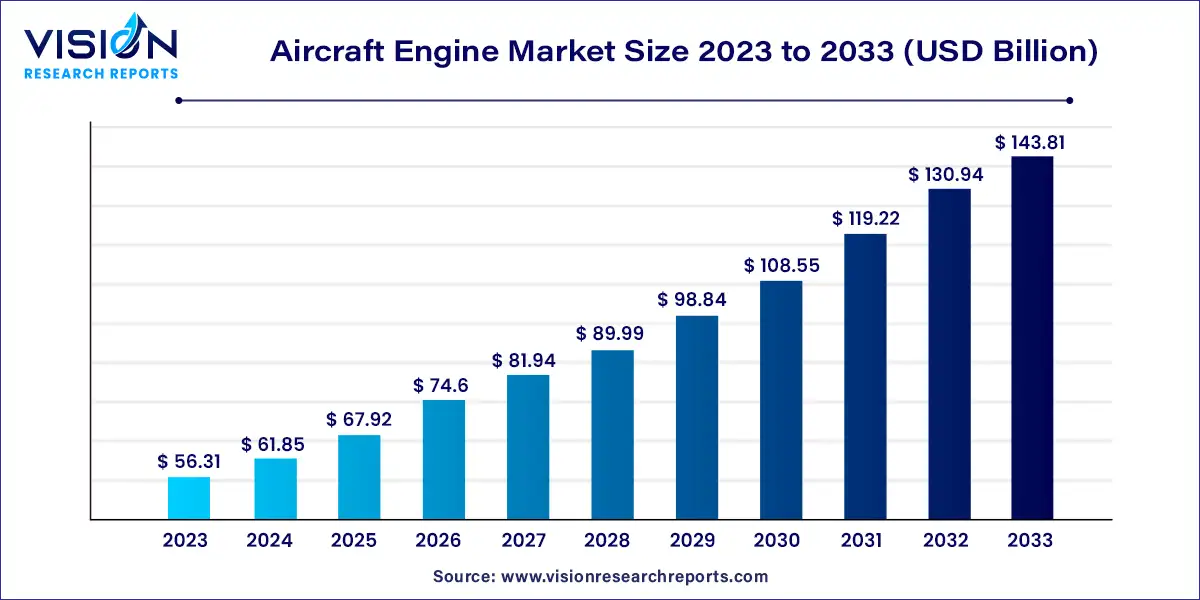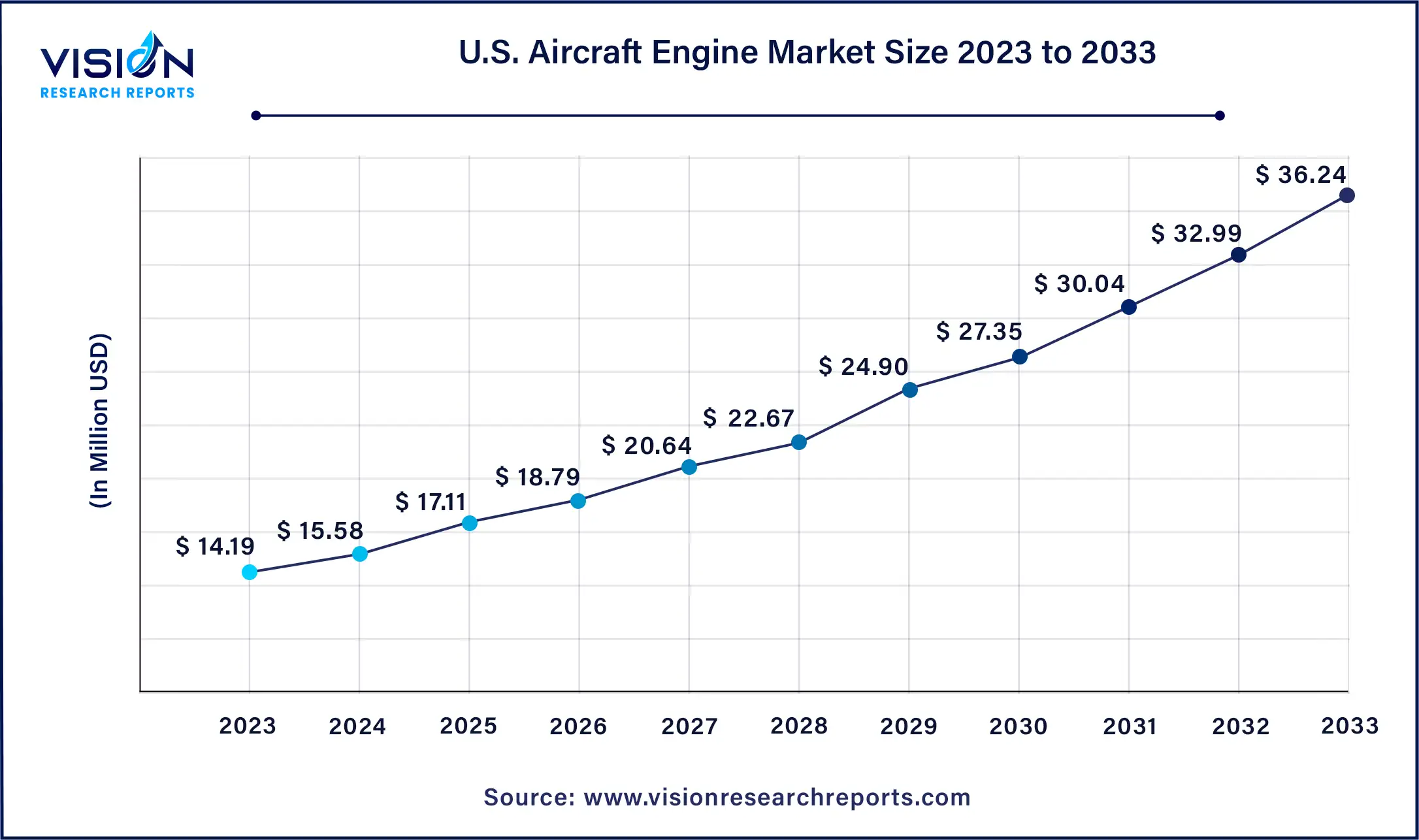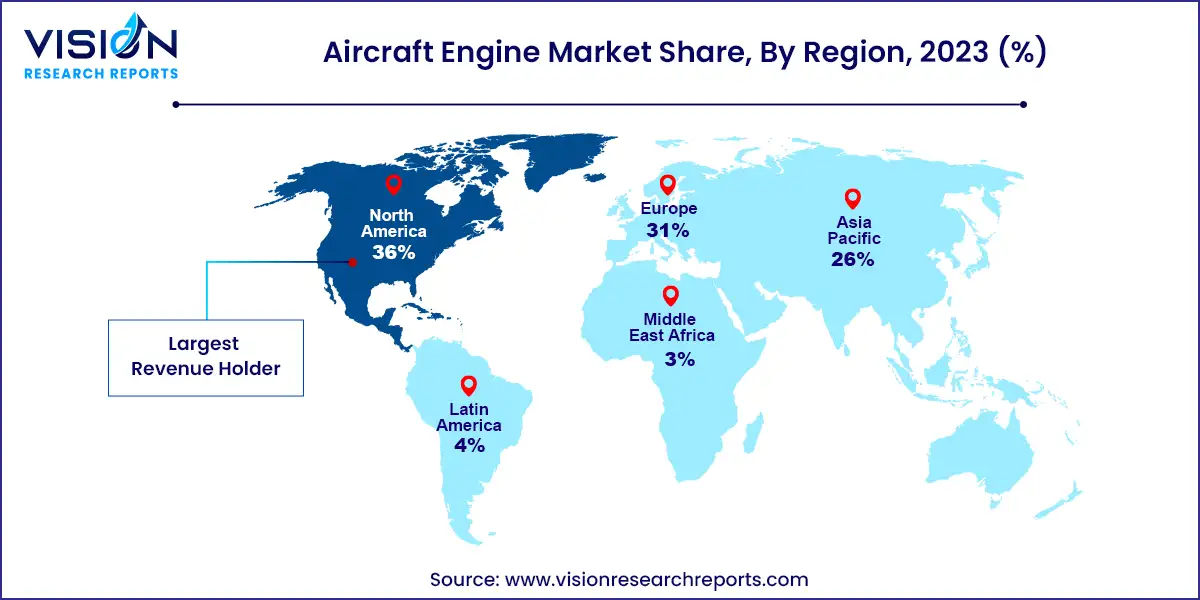The global aircraft engine market size was estimated at around USD 56.31 billion in 2023 and it is projected to hit around USD 143.81 billion by 2033, growing at a CAGR of 9.83% from 2024 to 2033. The aircraft engine market is a dynamic sector within the aerospace industry, characterized by continuous innovation and technological advancements. As a critical component of aircraft propulsion systems, engines play a pivotal role in determining performance, efficiency, and operational costs of both commercial and military aircraft.

The growth of the aircraft engine market is fueled by an increasing global air passenger traffic, coupled with a rising demand for fuel-efficient and environmentally friendly engines, drives continuous innovation in engine technology. Military modernization programs worldwide further bolster market expansion. Despite challenges such as high initial costs and stringent regulatory requirements, ongoing advancements in materials and digital technologies, like more electric aircraft (MEA) systems, promise to enhance efficiency and reliability. The competitive landscape, dominated by major players like GE Aviation, Rolls-Royce Holdings, and Pratt & Whitney, emphasizes ongoing research and development to meet future demands for performance, sustainability, and reduced environmental impact.
North America aircraft engine market captured the largest revenue share of 36% in 2023, driven by rising air travel demand, fleet expansions, and demand for fuel-efficient engines. Technological advancements in lightweight materials, advanced engine designs like geared turbofans, and enhanced maintenance practices are key growth factors. Regulatory shifts towards emissions reduction and noise abatement are prompting significant investments in engine efficiency, bolstering market prospects.
| Attribute | North America |
| Market Value | USD 20.27 Billion |
| Growth Rate | 9.82% CAGR |
| Projected Value | USD 51.77 Billion |
The U.S. aircraft engine market size was valued at USD 14.19 billion in 2023 and is anticipated to reach around USD 36.24 billion by 2033, growing at a CAGR of 9.82% from 2024 to 2033.

Asia Pacific aircraft engine market noteworthy revenue share in 2023, fueled by rapid expansion of airline fleets to meet escalating air travel demand. Emerging economies such as China and India are pivotal contributors, investing substantially in new aircraft acquisitions. Technological advancements in engine efficiency and the establishment of regional MRO facilities are augmenting market growth.

Japan Aircraft engine market expected to witness significant growth from 2024 to 2033, supported by collaborations with international engine manufacturers and advancements in aerospace technology. Japan's emphasis on high-performance, fuel-efficient engines for both commercial and defense applications is driving market expansion.
Turbofan engines dominated with 72% of revenue share in 2023, driven by robust demand in commercial and military aircraft sectors. Known for their fuel efficiency, reduced noise levels, and versatility across various flight conditions, manufacturers are intensifying efforts in advanced technologies like high-bypass ratio engines and geared turbofans to meet stringent environmental standards and enhance overall aircraft performance.
Turboshaft engines segment expected to achieve an 11% CAGR from 2024 to 2033, turboshaft engines are crucial for helicopters and rotorcraft, supporting diverse missions in military, medical, and commercial fields. Advances in design, focusing on power-to-weight ratios and fuel efficiency, are augmenting their operational reliability. Growing applications in emergency medical services, offshore operations, and military deployments are further propelling this specialized segment's growth.
Commercial aircraft segment leading in revenue share for 2023, this segment is driven by escalating global air travel demand. Airlines are investing in modern, fuel-efficient aircraft equipped with advanced engine technologies to enhance operational efficiency and environmental sustainability. Manufacturers are concentrating on high-thrust engines that offer improved fuel efficiency and emissions control, aligned with stringent regulatory requirements. Ongoing fleet modernization initiatives and expanding air connectivity are pivotal in sustaining demand for new engine installations.
Military aircraft segment projected to exhibit the highest CAGR from 2024 to 2033, bolstered by global defense modernization efforts and geopolitical dynamics. Governments are channeling investments into next-generation military aircraft equipped with advanced propulsion systems to enhance performance, stealth capabilities, and operational flexibility. Engine manufacturers are innovating with high-thrust engines tailored for military applications, emphasizing reliability, durability, and maintenance efficiency. Technological innovations such as adaptive cycle engines and enhanced fuel efficiency are key growth drivers in this strategic sector.
Aftermarket point of sale segment dominating market revenue in 2023, driven by escalating global air traffic and aging aircraft fleets. Airlines and operators prioritize efficient engine maintenance and repair services to maximize operational uptime and reduce costs. Advancements in predictive maintenance and data analytics are revolutionizing aftermarket services, offering tailored solutions for engine health monitoring and performance optimization. This segment's expansion underscores its critical role in sustaining the longevity and reliability of aircraft engines worldwide.
OEM point of sale segment expected to witness moderate CAGR from 2024 to 2033, fueled by rising global demand for new aircraft. Original Equipment Manufacturers (OEMs) are innovating with advanced engine technologies focused on fuel efficiency, reliability, and environmental sustainability. Increasing orders from airlines and leasing companies are bolstering growth, supported by advancements in engine design and manufacturing processes. Strategic partnerships and investments in research and development further strengthen OEMs' market position in the dynamic aerospace industry.
By Engine
By Aircraft
By Point of Sale
By Region
Chapter 1. Introduction
1.1. Research Objective
1.2. Scope of the Study
1.3. Definition
Chapter 2. Research Methodology
2.1. Research Approach
2.2. Data Sources
2.3. Assumptions & Limitations
Chapter 3. Executive Summary
3.1. Market Snapshot
Chapter 4. Market Variables and Scope
4.1. Introduction
4.2. Market Classification and Scope
4.3. Industry Value Chain Analysis
4.3.1. Raw Material Procurement Analysis
4.3.2. Sales and Distribution Engine Analysis
4.3.3. Downstream Buyer Analysis
Chapter 5. COVID 19 Impact on Aircraft Engine Market
5.1. COVID-19 Landscape: Aircraft Engine Industry Impact
5.2. COVID 19 - Impact Assessment for the Industry
5.3. COVID 19 Impact: Global Major Government Policy
5.4. Market Trends and Opportunities in the COVID-19 Landscape
Chapter 6. Market Dynamics Analysis and Trends
6.1. Market Dynamics
6.1.1. Market Drivers
6.1.2. Market Restraints
6.1.3. Market Opportunities
6.2. Porter’s Five Forces Analysis
6.2.1. Bargaining power of suppliers
6.2.2. Bargaining power of buyers
6.2.3. Threat of substitute
6.2.4. Threat of new entrants
6.2.5. Degree of competition
Chapter 7. Competitive Landscape
7.1.1. Company Market Share/Positioning Analysis
7.1.2. Key Strategies Adopted by Players
7.1.3. Vendor Landscape
7.1.3.1. List of Suppliers
7.1.3.2. List of Buyers
Chapter 8. Global Aircraft Engine Market, By Engine
8.1. Aircraft Engine Market, by Engine, 2024-2033
8.1.1 Turboprop
8.1.1.1. Market Revenue and Forecast (2021-2033)
8.1.2. Turbofan
8.1.2.1. Market Revenue and Forecast (2021-2033)
8.1.3. Turboshaft
8.1.3.1. Market Revenue and Forecast (2021-2033)
8.1.4. Piston Engine
8.1.4.1. Market Revenue and Forecast (2021-2033)
Chapter 9. Global Aircraft Engine Market, By Aircraft
9.1. Aircraft Engine Market, by Aircraft, 2024-2033
9.1.1. Commercial Aircraft
9.1.1.1. Market Revenue and Forecast (2021-2033)
9.1.2. Military Aircraft
9.1.2.1. Market Revenue and Forecast (2021-2033)
9.1.3. Business and General Aviation Aircraft
9.1.3.1. Market Revenue and Forecast (2021-2033)
Chapter 10. Global Aircraft Engine Market, By Point of Sale
10.1. Aircraft Engine Market, by Point of Sale, 2024-2033
10.1.1. OEM
10.1.1.1. Market Revenue and Forecast (2021-2033)
10.1.2. Aftermarket
10.1.2.1. Market Revenue and Forecast (2021-2033)
Chapter 11. Global Aircraft Engine Market, Regional Estimates and Trend Forecast
11.1. North America
11.1.1. Market Revenue and Forecast, by Engine (2021-2033)
11.1.2. Market Revenue and Forecast, by Aircraft (2021-2033)
11.1.3. Market Revenue and Forecast, by Point of Sale (2021-2033)
11.1.4. U.S.
11.1.4.1. Market Revenue and Forecast, by Engine (2021-2033)
11.1.4.2. Market Revenue and Forecast, by Aircraft (2021-2033)
11.1.4.3. Market Revenue and Forecast, by Point of Sale (2021-2033)
11.1.5. Rest of North America
11.1.5.1. Market Revenue and Forecast, by Engine (2021-2033)
11.1.5.2. Market Revenue and Forecast, by Aircraft (2021-2033)
11.1.5.3. Market Revenue and Forecast, by Point of Sale (2021-2033)
11.2. Europe
11.2.1. Market Revenue and Forecast, by Engine (2021-2033)
11.2.2. Market Revenue and Forecast, by Aircraft (2021-2033)
11.2.3. Market Revenue and Forecast, by Point of Sale (2021-2033)
11.2.4. UK
11.2.4.1. Market Revenue and Forecast, by Engine (2021-2033)
11.2.4.2. Market Revenue and Forecast, by Aircraft (2021-2033)
11.2.4.3. Market Revenue and Forecast, by Point of Sale (2021-2033)
11.2.5. Germany
11.2.5.1. Market Revenue and Forecast, by Engine (2021-2033)
11.2.5.2. Market Revenue and Forecast, by Aircraft (2021-2033)
11.2.5.3. Market Revenue and Forecast, by Point of Sale (2021-2033)
11.2.6. France
11.2.6.1. Market Revenue and Forecast, by Engine (2021-2033)
11.2.6.2. Market Revenue and Forecast, by Aircraft (2021-2033)
11.2.6.3. Market Revenue and Forecast, by Point of Sale (2021-2033)
11.2.7. Rest of Europe
11.2.7.1. Market Revenue and Forecast, by Engine (2021-2033)
11.2.7.2. Market Revenue and Forecast, by Aircraft (2021-2033)
11.2.7.3. Market Revenue and Forecast, by Point of Sale (2021-2033)
11.3. APAC
11.3.1. Market Revenue and Forecast, by Engine (2021-2033)
11.3.2. Market Revenue and Forecast, by Aircraft (2021-2033)
11.3.3. Market Revenue and Forecast, by Point of Sale (2021-2033)
11.3.4. India
11.3.4.1. Market Revenue and Forecast, by Engine (2021-2033)
11.3.4.2. Market Revenue and Forecast, by Aircraft (2021-2033)
11.3.4.3. Market Revenue and Forecast, by Point of Sale (2021-2033)
11.3.5. China
11.3.5.1. Market Revenue and Forecast, by Engine (2021-2033)
11.3.5.2. Market Revenue and Forecast, by Aircraft (2021-2033)
11.3.5.3. Market Revenue and Forecast, by Point of Sale (2021-2033)
11.3.6. Japan
11.3.6.1. Market Revenue and Forecast, by Engine (2021-2033)
11.3.6.2. Market Revenue and Forecast, by Aircraft (2021-2033)
11.3.6.3. Market Revenue and Forecast, by Point of Sale (2021-2033)
11.3.7. Rest of APAC
11.3.7.1. Market Revenue and Forecast, by Engine (2021-2033)
11.3.7.2. Market Revenue and Forecast, by Aircraft (2021-2033)
11.3.7.3. Market Revenue and Forecast, by Point of Sale (2021-2033)
11.4. MEA
11.4.1. Market Revenue and Forecast, by Engine (2021-2033)
11.4.2. Market Revenue and Forecast, by Aircraft (2021-2033)
11.4.3. Market Revenue and Forecast, by Point of Sale (2021-2033)
11.4.4. GCC
11.4.4.1. Market Revenue and Forecast, by Engine (2021-2033)
11.4.4.2. Market Revenue and Forecast, by Aircraft (2021-2033)
11.4.4.3. Market Revenue and Forecast, by Point of Sale (2021-2033)
11.4.5. North Africa
11.4.5.1. Market Revenue and Forecast, by Engine (2021-2033)
11.4.5.2. Market Revenue and Forecast, by Aircraft (2021-2033)
11.4.5.3. Market Revenue and Forecast, by Point of Sale (2021-2033)
11.4.6. South Africa
11.4.6.1. Market Revenue and Forecast, by Engine (2021-2033)
11.4.6.2. Market Revenue and Forecast, by Aircraft (2021-2033)
11.4.6.3. Market Revenue and Forecast, by Point of Sale (2021-2033)
11.4.7. Rest of MEA
11.4.7.1. Market Revenue and Forecast, by Engine (2021-2033)
11.4.7.2. Market Revenue and Forecast, by Aircraft (2021-2033)
11.4.7.3. Market Revenue and Forecast, by Point of Sale (2021-2033)
11.5. Latin America
11.5.1. Market Revenue and Forecast, by Engine (2021-2033)
11.5.2. Market Revenue and Forecast, by Aircraft (2021-2033)
11.5.3. Market Revenue and Forecast, by Point of Sale (2021-2033)
11.5.4. Brazil
11.5.4.1. Market Revenue and Forecast, by Engine (2021-2033)
11.5.4.2. Market Revenue and Forecast, by Aircraft (2021-2033)
11.5.4.3. Market Revenue and Forecast, by Point of Sale (2021-2033)
11.5.5. Rest of LATAM
11.5.5.1. Market Revenue and Forecast, by Engine (2021-2033)
11.5.5.2. Market Revenue and Forecast, by Aircraft (2021-2033)
11.5.5.3. Market Revenue and Forecast, by Point of Sale (2021-2033)
Chapter 12. Company Profiles
12.1. Advanced Atomization Technologies Inc.
12.1.1. Company Overview
12.1.2. Product Offerings
12.1.3. Financial Performance
12.1.4. Recent Initiatives
12.2. Enjet Aero.
12.2.1. Company Overview
12.2.2. Product Offerings
12.2.3. Financial Performance
12.2.4. Recent Initiatives
12.3. Engine Alliance.
12.3.1. Company Overview
12.3.2. Product Offerings
12.3.3. Financial Performance
12.3.4. Recent Initiatives
12.4. Safran Group.
12.4.1. Company Overview
12.4.2. Product Offerings
12.4.3. Financial Performance
12.4.4. Recent Initiatives
12.5. Pratt & Whitney.
12.5.1. Company Overview
12.5.2. Product Offerings
12.5.3. Financial Performance
12.5.4. Recent Initiatives
12.6. Rolls-Royce
12.6.1. Company Overview
12.6.2. Product Offerings
12.6.3. Financial Performance
12.6.4. Recent Initiatives
12.7. MTU Aero Engines AG.
12.7.1. Company Overview
12.7.2. Product Offerings
12.7.3. Financial Performance
12.7.4. Recent Initiatives
12.8. CFM International
12.8.1. Company Overview
12.8.2. Product Offerings
12.8.3. Financial Performance
12.8.4. Recent Initiatives
12.9. General Electric Company.
12.9.1. Company Overview
12.9.2. Product Offerings
12.9.3. Financial Performance
12.9.4. Recent Initiatives
12.10. ITP Aero
12.10.1. Company Overview
12.10.2. Product Offerings
12.10.3. Financial Performance
12.10.4. Recent Initiatives
Chapter 13. Research Methodology
13.1. Primary Research
13.2. Secondary Research
13.3. Assumptions
Chapter 14. Appendix
14.1. About Us
14.2. Glossary of Terms
 Cross-segment Market Size and Analysis for
Mentioned Segments
Cross-segment Market Size and Analysis for
Mentioned Segments
 Additional Company Profiles (Upto 5 With No Cost)
Additional Company Profiles (Upto 5 With No Cost)
 Additional Countries (Apart From Mentioned Countries)
Additional Countries (Apart From Mentioned Countries)
 Country/Region-specific Report
Country/Region-specific Report
 Go To Market Strategy
Go To Market Strategy
 Region Specific Market Dynamics
Region Specific Market Dynamics Region Level Market Share
Region Level Market Share Import Export Analysis
Import Export Analysis Production Analysis
Production Analysis Others
Others